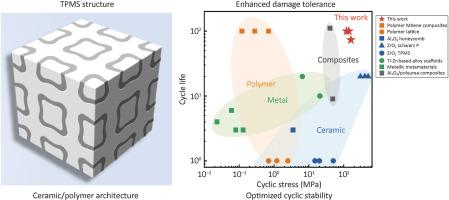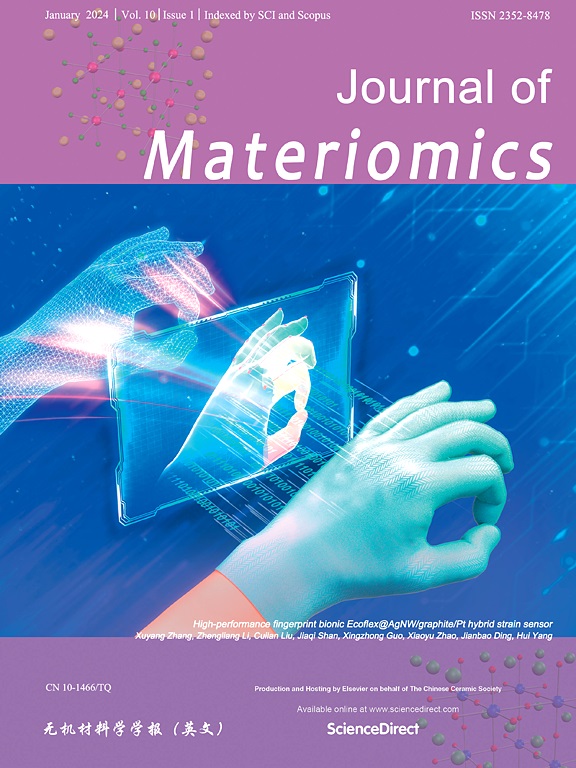Damage tolerance and cyclic stability of 3D-architected Al2O3/polymer composites
IF 9.6
1区 材料科学
Q1 CHEMISTRY, PHYSICAL
引用次数: 0
Abstract
The inherent brittleness and unpredictable catastrophic fracture of ceramic materials significantly limit their reliability in engineering applications, necessitating innovative approaches to enhance energy absorption capacity and cyclic load tolerance for structural components. This study presents a novel strategy for fabricating high-strength and cyclically-stable Al2O3/polymer composites through digital light processing (DLP) 3D printing of triply periodic minimal surface (TPMS) architectures combined with polymer infiltration. Mechanical characterization revealed exceptional quasi-static compressive strength of (201.9 ± 13.2) MPa coupled with remarkable energy absorption capacity reaching (40.1 ± 0.8) MJ/m3. The synergistic combination of TPMS structural design and extrinsic polymer toughening mechanisms induced progressive failure patterns characterized by extensive crack deflection and controlled interfacial debonding. Notably, the architected composites demonstrated outstanding cyclic durability, sustaining over 100 cycles at 60% and 70% maximum stress levels while maintaining 73 cycles at 80% stress level. Mechanical analysis attributed this performance enhancement to the polymer matrix's dual role in stress redistribution and energy dissipation accumulation during cyclic loading. This bioinspired structural design paradigm effectively addresses traditional ceramics' brittleness limitations, demonstrating significant potential for engineering applications in extreme environments requiring damage tolerance and load cycling reliability.

三维结构Al2O3/聚合物复合材料的损伤容限和循环稳定性
陶瓷材料固有的脆性和不可预测的灾难性断裂严重限制了其在工程应用中的可靠性,因此需要创新方法来提高结构构件的能量吸收能力和循环载荷承受能力。本研究提出了一种通过数字光处理(DLP) 3D打印结合聚合物渗透的三周期最小表面(TPMS)结构来制造高强度和循环稳定的Al2O3/聚合物复合材料的新策略。力学特性表明,准静态抗压强度为(201.9±13.2)MPa,吸能能力为(40.1±0.8)MJ/m3。TPMS结构设计和外源聚合物增韧机制的协同作用导致了以广泛裂纹挠曲和受控界面脱粘为特征的渐进式破坏模式。值得注意的是,这种结构复合材料表现出了出色的循环耐久性,在60%和70%的最大应力水平下可以维持100多次循环,而在80%的应力水平下可以维持73次循环。力学分析将这种性能增强归因于聚合物基体在循环加载过程中应力重新分布和能量耗散积累的双重作用。这种受生物启发的结构设计范式有效地解决了传统陶瓷的脆性限制,在需要损伤容限和载荷循环可靠性的极端环境中展示了巨大的工程应用潜力。
本文章由计算机程序翻译,如有差异,请以英文原文为准。
求助全文
约1分钟内获得全文
求助全文
来源期刊

Journal of Materiomics
Materials Science-Metals and Alloys
CiteScore
14.30
自引率
6.40%
发文量
331
审稿时长
37 days
期刊介绍:
The Journal of Materiomics is a peer-reviewed open-access journal that aims to serve as a forum for the continuous dissemination of research within the field of materials science. It particularly emphasizes systematic studies on the relationships between composition, processing, structure, property, and performance of advanced materials. The journal is supported by the Chinese Ceramic Society and is indexed in SCIE and Scopus. It is commonly referred to as J Materiomics.
 求助内容:
求助内容: 应助结果提醒方式:
应助结果提醒方式:


